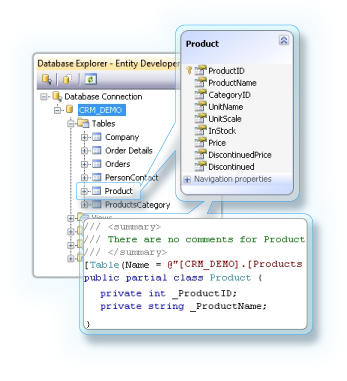Entity Developer is a powerful modeling and code generation tool for NHibernate, ADO.NET Entity Framework, LinqConnect, Telerik Data Access, and LINQ to SQL. You can use Model-First and Database-First approaches to design your model and generate C# or Visual Basic .NET code for it. It introduces new approaches for designing ORM models, boosts productivity, and facilitates the development of database applications.

 Visual ORM Model Designer with Code Generation
Visual ORM Model Designer with Code Generation
Entity Developer allows you to create and edit NHibernate, Entity Framework, Entity Framework Core, LinqConnect, Telerik Data Access, and LINQ to SQL models visually, without writing XML code. It supports creating all kinds of mapping, such as table splitting, mapping entity to several tables, complex types, inheritance hierarchies, creating entities from SELECT statements and methods from SQL code, etc. Code generation is very flexible due to using T4-like templates, allowing virtually anything you may want for code generation. C# and VB code can be generated for your model out-of-the-box, and you may even create your own templates for other programming languages. When designing and especially when debugging a model, it is often necessary to view and edit tables and view data, or fill tables with some test data. Entity Developer allows viewing and editing data of tables, views, and model entities, create and execute LINQ to SQL, Entity SQL and HQL queries against the model, eliminating the need for additional applications and reducing the time for accessing these operations. Besides, Entity Developer provides optimized performance and convenient work with large models at all stages of development. To make your model more understandable, you may split it into several thematic diagrams, each one having a part of model entities.
|
 Multiple ORM Support
Multiple ORM Support
Entity Developer supports NHibernate, Entity Framework (including Entity Framework Core), LinqConnect, Telerik Data Access, and LINQ to SQL models. It offers a separate edition for most of the supported ORMs and the Professional Edition, which supports all ORMs. Entity Developer for NHibernate allows designing NHibernate models using any ADO.NET providers for any DBMS, including dotConnects and Microsoft SqlClient. Entity Developer for Entity Framework and Entity Developer for LINQ to SQL use standard Microsoft SqlClient for database connection. Entity Developer is also included to the professional edition of dotConnect data providers for MySQL, Oracle, PostgreSQL, SQLite, and Salesforce and to LinqConnect. |
 Integration to Visual Studio
Integration to Visual Studio
Entity Developer seamlessly integrates with Visual Studio 2015, 2017, 2019, 2022 and 2026. You can edit your Entity Developer models as Visual Studio documents, in the same way as Entity Data Model models. Entity Developer toolbars and tool windows behave as native Visual Studio toolbars and tool windows, all Entity Developer functionality is available from Visual Studio menu. However, Entity Developer can be used as a stand-alone application, and it does not require Visual Studio to function. |
 Console Application
Console Application
In addition to standalone visual ORM designer and Visual Studio add-in, Entity Developer also provides a console application. It can generate model from database, code from model, create and update database from model scripts via the command line. |
 See Also
See Also
© 2008 - 2025 Devart. All rights reserved.
